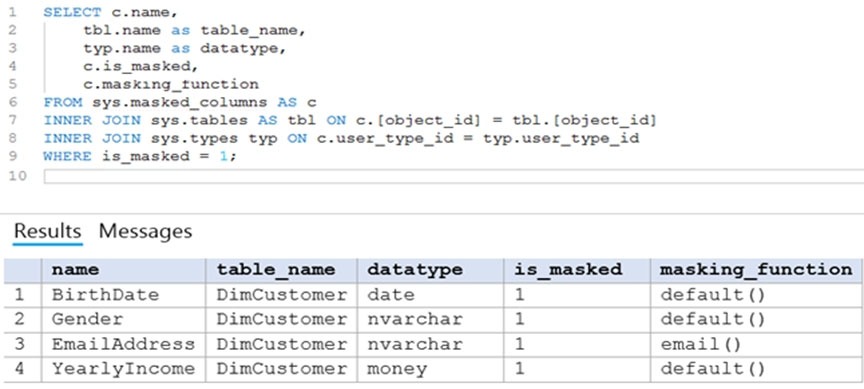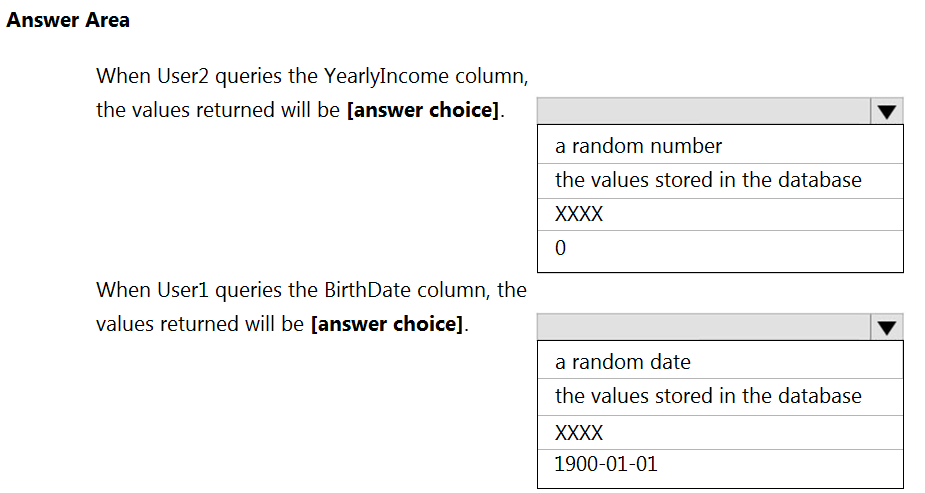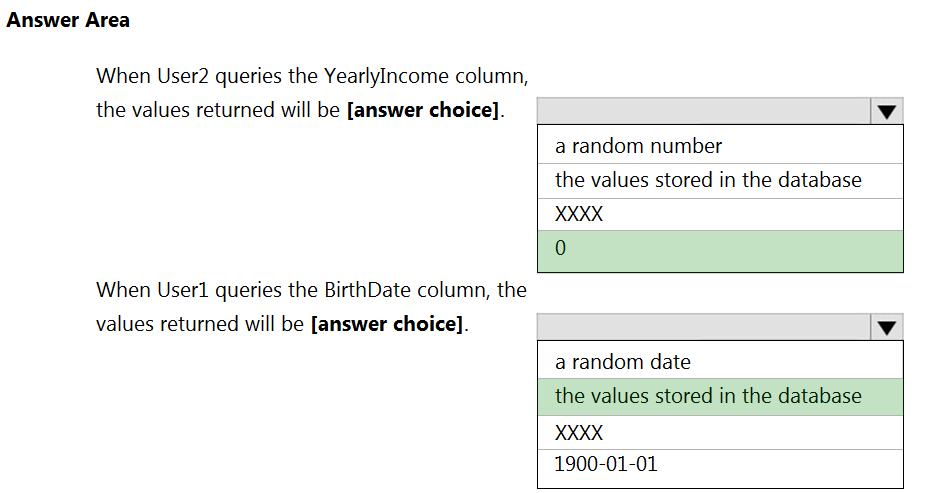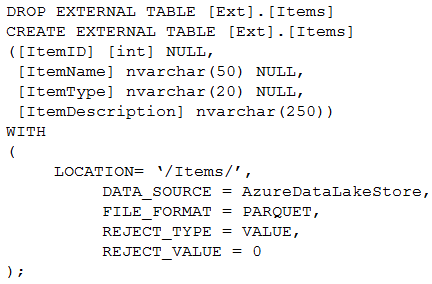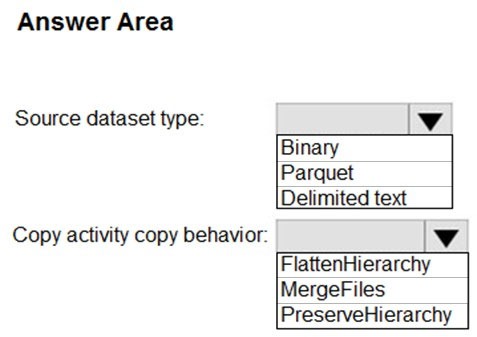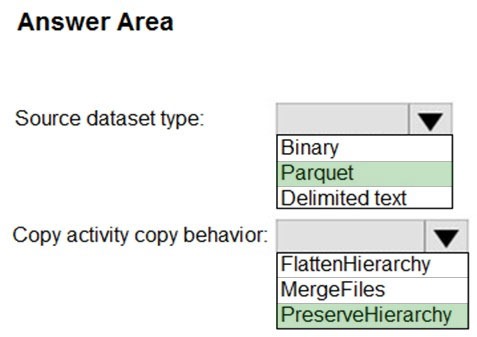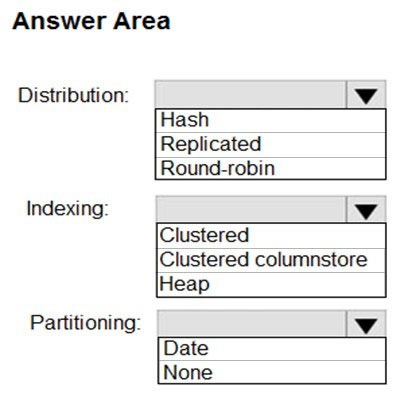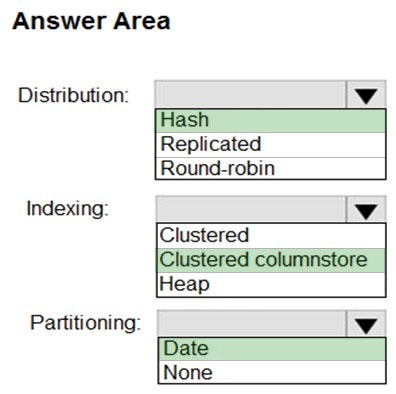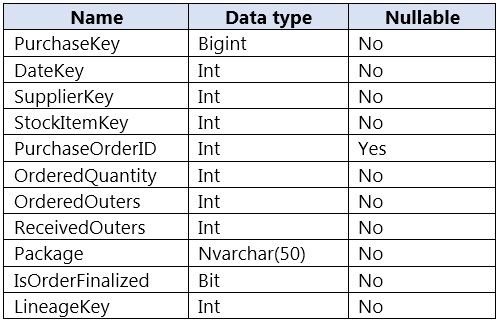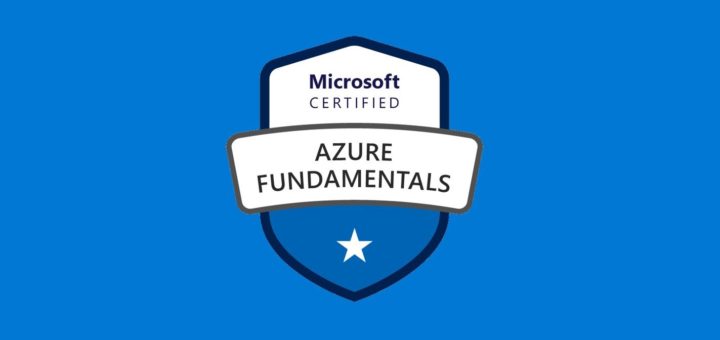Question #11
DRAG DROP –
You need to create a partitioned table in an Azure Synapse Analytics dedicated SQL pool.
How should you complete the Transact-SQL statement? To answer, drag the appropriate values to the correct targets. Each value may be used once, more than once, or not at all. You may need to drag the split bar between panes or scroll to view content.
NOTE: Each correct selection is worth one point.
Select and Place:
Correct Answer:
Box 1: DISTRIBUTION –
Table distribution options include DISTRIBUTION = HASH ( distribution_column_name ), assigns each row to one distribution by hashing the value stored in distribution_column_name.
Box 2: PARTITION –
Table partition options. Syntax:
PARTITION ( partition_column_name RANGE [ LEFT | RIGHT ] FOR VALUES ( [ boundary_value [,…n] ] ))
Reference:
https://docs.microsoft.com/en-us/sql/t-sql/statements/create-table-azure-sql-data-warehouse
Question #12
You need to design an Azure Synapse Analytics dedicated SQL pool that meets the following requirements:
✑ Can return an employee record from a given point in time.
✑ Maintains the latest employee information.
✑ Minimizes query complexity.
How should you model the employee data?
- A. as a temporal table
- B. as a SQL graph table
- C. as a degenerate dimension table
- D. as a Type 2 slowly changing dimension (SCD) table Most Voted
Correct Answer:D
A Type 2 SCD supports versioning of dimension members. Often the source system doesn’t store versions, so the data warehouse load process detects and manages changes in a dimension table. In this case, the dimension table must use a surrogate key to provide a unique reference to a version of the dimension member. It also includes columns that define the date range validity of the version (for example, StartDate and EndDate) and possibly a flag column (for example,
IsCurrent) to easily filter by current dimension members.
Reference:
https://docs.microsoft.com/en-us/learn/modules/populate-slowly-changing-dimensions-azure-synapse-analytics-pipelines/3-choose-between-dimension-types
D (100%)
Question #13
You have an enterprise-wide Azure Data Lake Storage Gen2 account. The data lake is accessible only through an Azure virtual network named VNET1.
You are building a SQL pool in Azure Synapse that will use data from the data lake.
Your company has a sales team. All the members of the sales team are in an Azure Active Directory group named Sales. POSIX controls are used to assign the
Sales group access to the files in the data lake.
You plan to load data to the SQL pool every hour.
You need to ensure that the SQL pool can load the sales data from the data lake.
Which three actions should you perform? Each correct answer presents part of the solution.
NOTE: Each area selection is worth one point.
- A. Add the managed identity to the Sales group. Most Voted
- B. Use the managed identity as the credentials for the data load process. Most Voted
- C. Create a shared access signature (SAS).
- D. Add your Azure Active Directory (Azure AD) account to the Sales group.
- E. Use the shared access signature (SAS) as the credentials for the data load process.
- F. Create a managed identity. Most Voted
Correct Answer: ABF
The managed identity grants permissions to the dedicated SQL pools in the workspace.
Note: Managed identity for Azure resources is a feature of Azure Active Directory. The feature provides Azure services with an automatically managed identity in
Azure AD –
Reference:
https://docs.microsoft.com/en-us/azure/synapse-analytics/security/synapse-workspace-managed-identity
ABF (100%)
Question #14
HOTSPOT –
You have an Azure Synapse Analytics dedicated SQL pool that contains the users shown in the following table.
User1 executes a query on the database, and the query returns the results shown in the following exhibit.
User1 is the only user who has access to the unmasked data.
Use the drop-down menus to select the answer choice that completes each statement based on the information presented in the graphic.
NOTE: Each correct selection is worth one point.
Hot Area:
Correct Answer:
Box 1: 0 –
The YearlyIncome column is of the money data type.
The Default masking function: Full masking according to the data types of the designated fields
✑ Use a zero value for numeric data types (bigint, bit, decimal, int, money, numeric, smallint, smallmoney, tinyint, float, real).
Box 2: the values stored in the database
Users with administrator privileges are always excluded from masking, and see the original data without any mask.
Reference:
https://docs.microsoft.com/en-us/azure/azure-sql/database/dynamic-data-masking-overview
Question #15
You have an enterprise data warehouse in Azure Synapse Analytics.
Using PolyBase, you create an external table named [Ext].[Items] to query Parquet files stored in Azure Data Lake Storage Gen2 without importing the data to the data warehouse.
The external table has three columns.
You discover that the Parquet files have a fourth column named ItemID.
Which command should you run to add the ItemID column to the external table?
A.
B.
C.
D.
Correct Answer: C
Incorrect Answers:
A, D: Only these Data Definition Language (DDL) statements are allowed on external tables:
✑ CREATE TABLE and DROP TABLE
✑ CREATE STATISTICS and DROP STATISTICS
✑ CREATE VIEW and DROP VIEW
Reference:
https://docs.microsoft.com/en-us/sql/t-sql/statements/create-external-table-transact-sql
Question #16
HOTSPOT –
You have two Azure Storage accounts named Storage1 and Storage2. Each account holds one container and has the hierarchical namespace enabled. The system has files that contain data stored in the Apache Parquet format.
You need to copy folders and files from Storage1 to Storage2 by using a Data Factory copy activity. The solution must meet the following requirements:
✑ No transformations must be performed.
✑ The original folder structure must be retained.
✑ Minimize time required to perform the copy activity.
How should you configure the copy activity? To answer, select the appropriate options in the answer area.
NOTE: Each correct selection is worth one point.
Hot Area:
Correct Answer:
Box 1: Parquet –
For Parquet datasets, the type property of the copy activity source must be set to ParquetSource.
Box 2: PreserveHierarchy –
PreserveHierarchy (default): Preserves the file hierarchy in the target folder. The relative path of the source file to the source folder is identical to the relative path of the target file to the target folder.
Incorrect Answers:
✑ FlattenHierarchy: All files from the source folder are in the first level of the target folder. The target files have autogenerated names.
✑ MergeFiles: Merges all files from the source folder to one file. If the file name is specified, the merged file name is the specified name. Otherwise, it’s an autogenerated file name.
Reference:
https://docs.microsoft.com/en-us/azure/data-factory/format-parquet https://docs.microsoft.com/en-us/azure/data-factory/connector-azure-data-lake-storage
Question #17
You have an Azure Data Lake Storage Gen2 container that contains 100 TB of data.
You need to ensure that the data in the container is available for read workloads in a secondary region if an outage occurs in the primary region. The solution must minimize costs.
Which type of data redundancy should you use?
- A. geo-redundant storage (GRS) Most Voted
- B. read-access geo-redundant storage (RA-GRS) Most Voted
- C. zone-redundant storage (ZRS)
- D. locally-redundant storage (LRS)
Correct Answer: B
Geo-redundant storage (with GRS or GZRS) replicates your data to another physical location in the secondary region to protect against regional outages.
However, that data is available to be read only if the customer or Microsoft initiates a failover from the primary to secondary region. When you enable read access to the secondary region, your data is available to be read at all times, including in a situation where the primary region becomes unavailable.
Incorrect Answers:
A: While Geo-redundant storage (GRS) is cheaper than Read-Access Geo-Redundant Storage (RA-GRS), GRS does NOT initiate automatic failover.
C, D: Locally redundant storage (LRS) and Zone-redundant storage (ZRS) provides redundancy within a single region.
Reference:
https://docs.microsoft.com/en-us/azure/storage/common/storage-redundancy
A (77%)
B (23%)
Question #18
You plan to implement an Azure Data Lake Gen 2 storage account.
You need to ensure that the data lake will remain available if a data center fails in the primary Azure region. The solution must minimize costs.
Which type of replication should you use for the storage account?
- A. geo-redundant storage (GRS)
- B. geo-zone-redundant storage (GZRS)
- C. locally-redundant storage (LRS)
- D. zone-redundant storage (ZRS) Most Voted
Correct Answer: D
Zone-redundant storage (ZRS) copies your data synchronously across three Azure availability zones in the primary region.
Incorrect Answers:
C: Locally redundant storage (LRS) copies your data synchronously three times within a single physical location in the primary region. LRS is the least expensive replication option, but is not recommended for applications requiring high availability or durability
Reference:
https://docs.microsoft.com/en-us/azure/storage/common/storage-redundancy
D (99%)
1%
Question #19
HOTSPOT –
You have a SQL pool in Azure Synapse.
You plan to load data from Azure Blob storage to a staging table. Approximately 1 million rows of data will be loaded daily. The table will be truncated before each daily load.
You need to create the staging table. The solution must minimize how long it takes to load the data to the staging table.
How should you configure the table? To answer, select the appropriate options in the answer area.
NOTE: Each correct selection is worth one point.
Hot Area:
Correct Answer:
Box 1: Hash –
Hash-distributed tables improve query performance on large fact tables. They can have very large numbers of rows and still achieve high performance.
Incorrect Answers:
Round-robin tables are useful for improving loading speed.
Box 2: Clustered columnstore –
When creating partitions on clustered columnstore tables, it is important to consider how many rows belong to each partition. For optimal compression and performance of clustered columnstore tables, a minimum of 1 million rows per distribution and partition is needed.
Box 3: Date –
Table partitions enable you to divide your data into smaller groups of data. In most cases, table partitions are created on a date column.
Partition switching can be used to quickly remove or replace a section of a table.
Reference:
https://docs.microsoft.com/en-us/azure/synapse-analytics/sql-data-warehouse/sql-data-warehouse-tables-partition https://docs.microsoft.com/en-us/azure/synapse-analytics/sql-data-warehouse/sql-data-warehouse-tables-distribute
Question #20
You are designing a fact table named FactPurchase in an Azure Synapse Analytics dedicated SQL pool. The table contains purchases from suppliers for a retail store. FactPurchase will contain the following columns.
FactPurchase will have 1 million rows of data added daily and will contain three years of data.
Transact-SQL queries similar to the following query will be executed daily.
SELECT –
SupplierKey, StockItemKey, IsOrderFinalized, COUNT(*)
FROM FactPurchase –
WHERE DateKey >= 20210101 –
AND DateKey <= 20210131 –
GROUP By SupplierKey, StockItemKey, IsOrderFinalized
Which table distribution will minimize query times?
- A. replicated
- B. hash-distributed on PurchaseKey Most Voted
- C. round-robin
- D. hash-distributed on IsOrderFinalized
Correct Answer: B
Hash-distributed tables improve query performance on large fact tables.
To balance the parallel processing, select a distribution column that:
✑ Has many unique values. The column can have duplicate values. All rows with the same value are assigned to the same distribution. Since there are 60 distributions, some distributions can have > 1 unique values while others may end with zero values.
✑ Does not have NULLs, or has only a few NULLs.
✑ Is not a date column.
Incorrect Answers:
C: Round-robin tables are useful for improving loading speed.
Reference:
https://docs.microsoft.com/en-us/azure/synapse-analytics/sql-data-warehouse/sql-data-warehouse-tables-distribute
B (82%)



